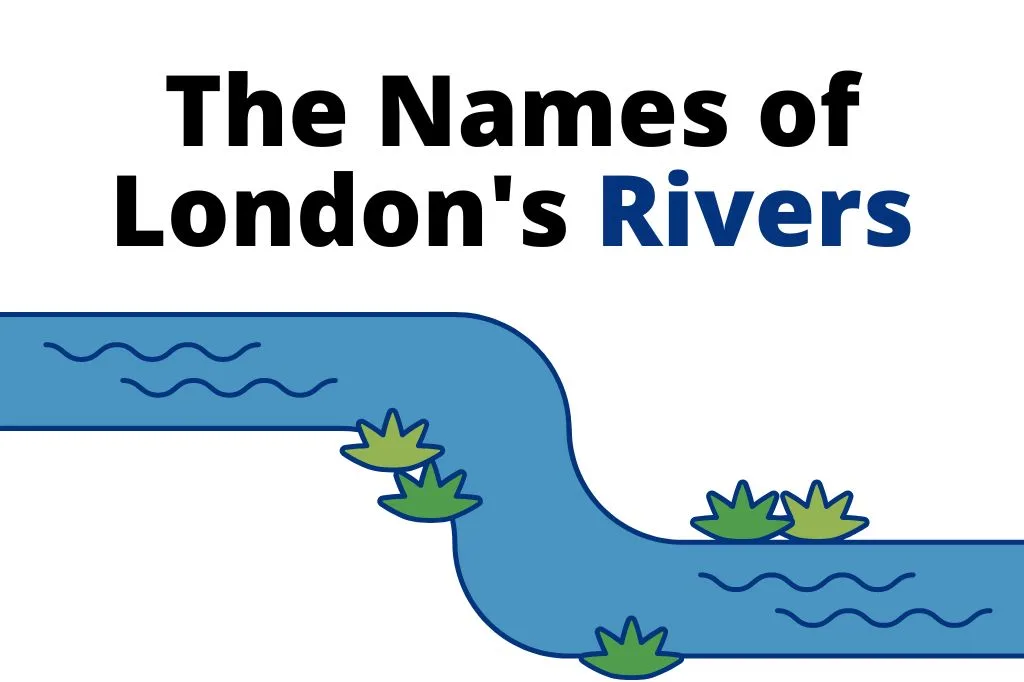London has over twenty different rivers which have been forced underground over the centuries. Today, apart from the River Thames, there are seven London rivers that remain almost entirely above ground: the River Wandle, the River Lea, the River Brent, Beverley Brook, the River Roding, the River Ingrebourne, and the Hogsmill River.
This posts list the names of all of London’s rivers.

How Many Rivers Are in London?
There are 26 main rivers in London. This includes the River Thames, plus 25 tributaries which flow into the Thames.
River Thames
The River Thames is London’s main river. It is 215 miles long which makes it the second longest river in the United Kingdom.
The Thames starts in the Cotsworlds in Gloucestershite, and runs through Oxford, Reading and Windsor, before it reaches Teddington and flows through the heart of London, to the Thames Estuary.
The Thames is the only river in Europe that has a national trail which follows its entire length.
Tributaries of the River Thames
In total the Thames has 38 main tributaries, 25 of which are in the London area.

What Are The Names of The Rivers in London?
The list below includes the names of all twenty five rivers in the London area, that flow into the River Thames.
Almost all of these rivers are now buried underground, although some rivers like the Quaggy and Rom are only partially underground. Many of them have become integral parts of London’s sewer system.
- Beam
- Beverley Brook
- Bollar or Bollo Brook
- Brent
- Counter’s Creek
- Crane
- Duke of Northumberland’s River
- Effra
- Falconbrook
- Fleet
- Hogsmill River
- Ingrebourne
- Lea
- Longford River
- Mole
- Neckinger
- Ravensbourne
- Roding
- Stamford Brook
- Sudbrook
- The Rythe
- Tyburn
- Walbrook
- Wandle
- Westbourne

What are the Lost Rivers of London?
The dozens of rivers that are buried beneath London’s streets are known as the “lost rivers” of London. Although London’s subterranean rivers are not visible anymore, their original route can still be traced above ground.
River Fleet
The River Fleet is the largest of London’s subterranean rivers.
Parts of the old River Fleet can be found flowing from Hampstead to Highgate Ponds in North London before it turns into a sewer that flows to Blackfriars Bridge.
The River Fleet was once a broad tidal basin, and its waters were believed to have healing properties. Eventually it developed a reputation for being a slum. It was a place of crime and disease, and the location of Fagen’s deg in Charles Dickens’s novel Oliver Twist.
The butchers would throw the dead bodies of animals into the Fleet in Smithfields, and over time the river became an open sewer. Today it is used as an underground sewer.
The River Fleet gave its name to Fleet Street. There was also once a crossing over the river called Fleet Bridge, which is today the site of Ludgate Circus.
River Tyburn
The River Tyburn runs directly under Buckingham Palace. In history it was known as a place for salmon fishing, but today it is a sewer.
The path of the Tyburn ran from South Hampstead through Marylebone, St James’ district and Green Park. The shape of the road in Piccadilly still has a dip in it where the original course of the River Tyburn ran.
River Walbrook
The River Walbrook was one of the first rivers in London to be buried.
When the Romans settled in Londinium around AD 47–50, they built the Temple of Mithras, on the banks of the River Walbrook. Their settlement was centred around the junction of the Walbrook and the Thames.
The Romans used the river as a source of water, and for worship. The name “Walbrook”, may have originated from the fact that the river flowed along and underneath the city wall.
The temple of Mithras that once stood next to the River Walbrook was discovered during the Blitz in 1941, and excavated by Bloomberg.
Today the River Walbrook still flows underneath the Bank of England and Mansion House. The photograph below shows the remains of the Temple of Mithras which you can visit.

River Westbourne
The River Westbourne flows from Hampstead and Brondesbury Park to Kilburn, Bayswater and the west end of Paddington.
Today you can see the original river Wesbourne running above Sloane Square tube station through a large green bridge that runs above the track and platform.
River Effra
The River Effra once flowed from Crystal Palace, through Herne Hill, Brixton and Kennington, before reaching the Thames near Vauxhall Bridge.
In “Thames: Sacred River”, Peter Ackroyd writes that the river took its name from the Celtic word ‘yfrid,’ which means ‘torrent’. It is more likely however that it was named after the old Effra Farm that the river once flowed through.
The Oval cricket ground was built into a bend in the River Effra. You can see the stadium has raised banks from when the river was built over.
Map of the Rivers in London
The map below shows all the rivers, docks and waterways flowing in London. The map includes the rivers which are above ground, as well as hidden rivers.

Poem About London’s Lost Rivers
Rising Damp, by U.A. Fanthorpe
At our feet they lie low,
The little ferment underground
Rivers of London
Effra, Graveney, Falcon, Quaggy,
Wandle, Walbrook, Tyburn, Fleet
Whose names are disfigured,
Frayed, effaced.
These are the Magogs that chewed the day
To the basin that London nestle in.
These are the currents that chiselled the city,
That washed the clothes and turned the mills,
Where children drank and salmon swam
And wells were holy.
They have gone under
Boxed, like the magician’s assistant.
Buried alive in earth.
Forgotten, like the dead.
They return spectrally after heavy rain,
Confounding suburban gardens. They infiltrate
Chronic bronchitis statistics. A silken
Slur haunts dwellings by shrouded
Watercourses and is taken
For the footing of the dead.
Being of our world, they will return
(Westbourne, cages at Sloane Square,
Will jack from his box).
Will deluge cellars, detonate manholes,
Plant effluent on our faces,
Sink the city.
Effra, Graveney, Falcon, Quaggy,
Wandle, Walbrook, Tyburn, Fleet
It is the other rivers that lie
Lower, that touch us only in dreams
That never surface. We feel their tug
As a dowsers rod bends to the source below.
Phlegethon, Acheron, Lethe, Styx.
Other Posts About London’s Rivers
How Many Rivers Are in London?
Thank you for reading my post about how many rivers are in London. I’m aware this isn’t a complete list as they are other waterways, docks and wharves, as well as the tributaries of the rivers mentioned in this post. I’ve included however all the main underground rivers of London that run through central London and beyond.
